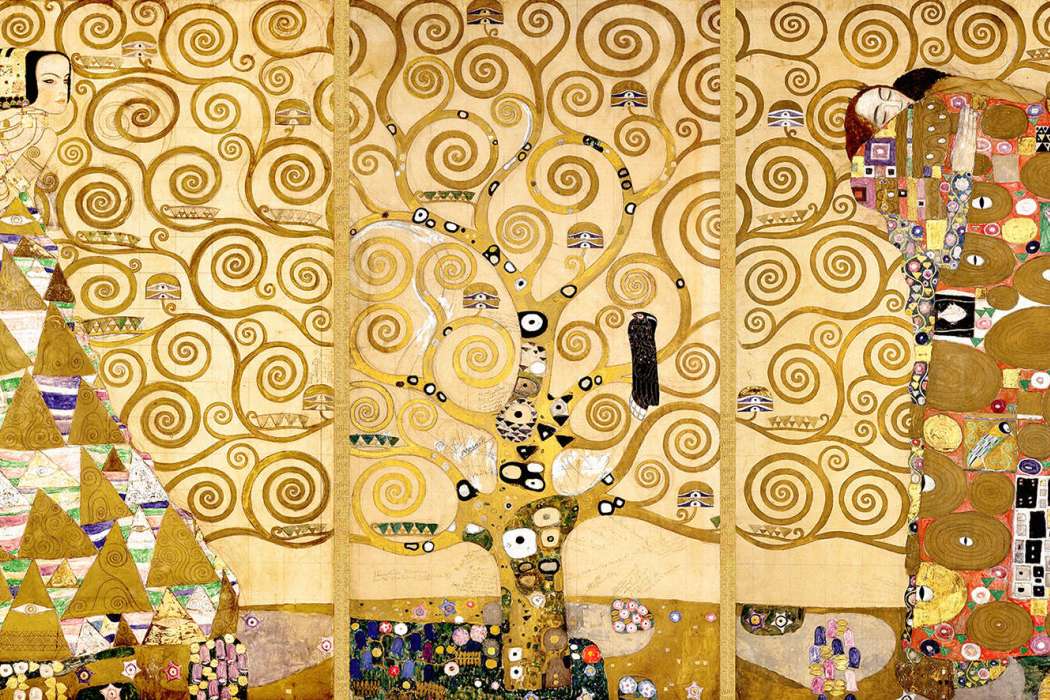 Edit article
Edit articleSeries
Observance or Faith? Jews and Christians Contend Over Abraham’s Legacy

The Tree of Life Gustav Klimt 1909
The Jesus movement started as an apocalyptic sect in Galilee in the late 20s and early 30s C.E.[1] In the years following his crucifixion in 30 or 33 C.E., some of his disciples, most famously Peter and John, along with Jesus’ brother James, moved their activities to Jerusalem, recentering the movement as a Judean one, a term that implies geographic place, law, ritual, sacred texts and other “religious” narratives, and relation to a particular God.[2] At the beginning of the Jesus movement, there is no evidence for any concerted effort to enlist non-Judeans into the sect, nor was there any specific policy defining which Judean laws and norms were to be followed by non-Judeans who joined.[3] Then came Paul of Tarsus.
Writing in the 50s of the Common Era, Paul describes himself as Judean, albeit a sectarian one, belonging to the subgroup of devotees of Jesus,[4] and he characteristically makes distinctions between Judeans and other ethnē “nations” (Rom 1:16; 2:9).[5] He claims, not without some exaggeration, that he “advanced in the Judean way of life[6] beyond many of [his] contemporaries … being exceedingly zealous for the traditions of [his] ancestors” (Gal 1:13–14).[7] Though Paul was Judean, he also viewed himself as God’s own “emissary to the nations,” whose mission was to exhort non-Judeans to revere the God of Israel and to await Jesus’ descent from heaven at the time of the apocalyptic judgment.[8]
By the early 40s C.E., Paul had taken it upon himself to recruit non-Judeans from cities across the eastern and northern Mediterranean, and he developed new policies on which aspects of Judean law they should follow. Contrary to a popular view, Paul did not advocate “salvation by faith alone”—it was not until the 1500s that Martin Luther developed that idea.[9] Rather, Paul advocated that non-Judeans follow some but not all aspects of Judean law: revering the God of Israel, rejecting idols, and avoiding sexual immorality, adultery, theft, envy, drunkenness, and sorcery, for example, corresponding to injunctions in the Torah.[10] Paul did not advocate other practices like circumcision, or observing the Sabbath or dietary laws, for non-Judean adherents to the movement.[11]
Non-Judeans Need Not Be Circumcised Like Judeans to Join the Community
As part of his ministry, Paul established a community of gentile Christ-followers in Galatia (modern Turkey) according to his principles. At some point, other emissaries within the movement convince this community that they must circumcise, and when Paul hears of this, he writes them a letter—later named the Epistle to the Galatians (53–54 C.E.)—rebuking them:[12]
Gal 2:15 We (=Paul and Peter) ourselves are Judeans by nature (physei) and not sinners from among the nations [ethnē] 2:16 yet we know that a person is justified not by the works of the law but through the faithfulness of Jesus Christ. And we have come to trust in Christ Jesus, so that we might be justified by the faithfulness of Christ and not by doing the works of the law, because no one will be justified by the works of the law.[13]
And yet, since God commands Abraham not only to circumcise himself, but also his offspring, how can he justify saying that new members of God’s community need not circumcise?
Paul notes that immediately after God promises Abraham that he will become אַב־הֲמוֹן גּוֹיִם “the forefather of multitude of nations [ethnē],”[14] God also makes a covenant that extends to Abraham’s “seed” or “offspring” [זרע, spermati], a term that appears in the singular, not the plural,[15] and proposes the novel interpretation:
Gal 3:16 The promises were spoken to Abraham ‘and to his seed’; it does not say, ‘and to his seeds,’ as concerning many, but as concerning one: ‘and to your seed’—that is Christ.[16]
Thus, Paul argues, in addition to Abraham’s physical, biological descendants, the Israelites, the covenant with Abraham also connects to those who exhibit “faithfulness” [Greek pistis] toward Christ.[17] Indeed, Paul argues, this covenant predates the revelation at Sinai:
Gal 3:17 My point is this: the law, which came four hundred thirty years later,[18] does not annul a covenant previously ratified by God, so as to nullify the promise.
Alluding to the ritual of baptism, involving full immersion in water, understood as a ritual of induction into an assembly of Christ-devotees, Paul draws together the threads of the argument:
Gal 3:27 For you are all sons of God through faithfulness [pistis] toward Jesus Christ, for as many as have been baptized into Christ have been clothed with Christ.… 3:29 And if you belong to Christ, you are Abraham’s offspring, heirs according to the promise.[19]
Abraham’s Two Wives and Two Sons (Galatians)
To further ground his argument in the Abraham narrative (Gal 4:21–31), Paul notes that the patriarch fathered two sons: Isaac, the son of his wife Sarah, who was in line to inherit Abraham’s estate, and Ishmael, the son of Sarah’s enslaved Egyptian woman Hagar, who was expelled (Gen 16:1–17:27; 21:1–21). He reads the story as an allegory:[20]
Hagar, the slave woman, represents Mount Sinai, and correlates with the “present” (νῦν) physical city of Jerusalem.
Sarah, the free woman, represents the heavenly “Jerusalem above,” which he expected would descend to earth in an apocalyptic future.[21]
The two women do not represent “Judaism” and “Christianity”—constructs that did not yet exist[22]—but two different groups of Christ followers, advocating for two irreconcilable courses of action:
Rival group—emissaries of Christ, who argue that males among the Galatian assembly needed to become circumcised (Gal 1:6–9; 4:17; 6:12).
Paul—emissary to the non-Judeans, who argues that they connect to Jesus by faithfulness, not works, and thus should remain uncircumcised (Gal 5:2–4; 6:11–16).[23]
Paul is not dividing between “Jews” and “Christians” nor between Judeans and “Gentiles,”[24] but among two groups of Christ-followers: it is the opposing group of emissaries of Christ, who advocate that non-Judeans entering the fold circumcise in accordance with the law, that are being rejected like Hagar. The fact that Paul here includes both himself and his Galatian addressees among the “sons of Sarah” demonstrates clearly that he is not speaking with the usual ethnic categories in mind here.
God Counts Abraham as Righteous (Romans)
Paul revisits these issues in his far less polemical letter to the assembly of Christ-devotees in Rome (57 C.E.). This time, he points out that “Abraham trusted God, and it was reckoned to him as righteousness” (Gen 15:6)[25] before Abraham was circumcised, when he was still “foreskinned” (Gen 17). Thus, Paul reasons:
Rom 4:11–13 [Abraham] received the sign of circumcision as a seal of the righteousness [that was reckoned to him] on the basis of his faithfulness [pisteōs] when he was foreskinned, so that he might be the father of all who are faithful [pisteuontōn] while foreskinned, so that righteousness might be reckoned to them, and (so that he might be) the forefather of the circumcised, not only to those who are circumcised but also to those who follow in the footsteps of our forefather Abraham by faithfulness while foreskinned. [26]
Put succinctly, Abraham is the forefather of the ethnē within Christ’s assembly in Rome simply because they, like Abraham, were characterized by faithfulness toward God “while foreskinned;” circumcision is not required of them as non-Judeans.[27] The genealogy Paul constructs for his ethnic addressees exists alongside the “biological” descent attributed to Judeans as a supplement: Abraham is the forefather both of circumcised Judeans and of Christ-devoted, uncircumcised non-Judeans.[28]
Gentiles are the Grafted Branch on the Israelite Olive Tree
At the same time, Paul reminds the gentile Christ-followers of Rome not to disrespect Judeans, who are God’s chosen people (Rom 9:11). Think of them as the trunk of an olive tree,[29] he says, while you are branches grafted on to it:
Romans 11:17 But if some of the branches were broken off, and you, a wild olive shoot, were grafted among the others to share the rich root of the olive tree, 11:18 do not boast over the branches. If you do boast, remember: you do not support the root, but the root supports you.
Paul portrays Israel here as the base or “root stock” that supports the non-Judean Christ-followers who, like “wild” or uncultivated branches, were grafted on, nourished and sustained by the rich oil supplied by the rootstock. Once grafted onto the stock, the “wild” non-Judeans were able to “share in common the rich oil [i.e., the sap] of the rootstock”; that is, the sustaining history, traditions, and promises made to Israel (Rom 9:4–5).[30]
Admittedly, some of the branches of the cultivated olive tree, Israel, would be “torn off”[31] —i.e., Judeans who are not members of the Christ-sect—so that the branches of wild olives (=“faithful” gentiles) could be grafted on. Yet, Paul warns, that this just proves any branch can be broken off, including their own, if found wanting:
Romans 11:19 You will say, “Branches were broken off so that I might be grafted in.” 11:20 That is true. They were broken off on account of unbelief, but you stand on account of belief. So do not become arrogant, but be afraid. 11:21 For if God did not spare the natural branches, neither will he spare you....
In the end, Paul argues, removal of cultivated branches is only temporary; Judeans who come to embody “faithfulness” toward Jesus[32] will be regrafted onto the tree:
Romans 11:23 And even those of Israel, if they do not continue in unbelief, will be grafted in, for God has the power to graft them in again. 11:24 For if you have been cut from what is by nature a wild olive tree and grafted, contrary to nature, into a cultivated olive tree, how much more will these natural branches be grafted back into their own olive tree.
In this imagined apocalyptic future, Judeans would eventually join the sect of Christ-devotees, based on “trust and reliance” (pistis) toward Jesus as the messiah, and “all Israel will be saved” in the last judgment (Rom 11:26).
Justin, John Chrysostom, and the Invention of Christianity as a Religion (2nd–4th cent. C.E.)
As seen above, Paul can hardly be credited with supersessionist notions, and yet, Justin Martyr (ca. 100–165 C.E.) understood his letters to indicate that the death and resurrection Jesus had initiated a “new covenant” that Christians, not Judeans, had inherited; Christians, Justin opined, had now become the “true, spiritual Israel.”[33]
Going further with this doubtful interpretation of Paul, John Chrysostom (ca. 347–407 C.E.) reimagined Paul’s grafting imagery as saying that “the Jews” were branches that had been broken off from God’s “tree”; as they refused to accept the yoke of Christ, God rejected them in favor of the Christians.[34] Chrysostom divided all of humanity into three broad religious groups: Christians, Jews, and pagans, the last being a “catch-all” designation for those who did not fall into either of the first two groups.
In other words, Justin and Chrysostom considered Judaism and Christianity conflicting religions, the latter superseding or replacing, and improving upon the now defunct former.[35] Looking back at Paul’s two groups, they understood the rejected Hagar as Jews and the beloved Sarah as Christians.
This division of groups based on religion was part of a broad rethinking of categories in Rome, useful in defining and uniting an empire that was composed of a patchwork of different peoples from different geographic regions. In Paul’s day, ethnicity, geography, and belief systems were intertwined when describing groups like Judeans, but this gradually changed in the 2nd and 3rd centuries. By the time Emperor Theodosius I (r. 379–395 C.E.)—a contemporary of Chrysostom—issued an edict making Christianity Rome’s official “religion” in 380 C.E., the category of religion had largely replaced ethnos as the way in which people and groups were identified.[36]
A Jewish Counternarrative: Genesis Rabbah’s Response
As Christianity, now understood as a religion, was spreading throughout the Roman Empire in late antiquity, a new mode of Jewish identity was also coalescing around the institution of the synagogue and the biblical interpretations of the Rabbis,[37] who believed that the Torah contained within it all that one might need to live. They argued that while the Temple was no more, Jewish communities remained bound by the covenant their ancestors had made with God at Mount Sinai.[38]
As part of their effort to influence the way that their ethnically Judean audiences understood themselves, the Rabbis display an awareness of the kinds of arguments contemporary Roman Christians were making about Scripture. Given that the Torah presents Abraham as an ancestor and role model for the people of Israel,[39] it is only to be expected that those who saw themselves as true Israel felt it necessary to show that they were continuing his legacy. And this was true for the rabbis as much or even more than it was for Paul, especially once Christian readers reinterpreted Paul’s letters to say that Jews were no longer part of Abraham’s heritage.[40]
In Genesis Rabbah,[41] the rabbis subtly respond to Paul’s claim that Abraham’s greatness was based on his faith, by emphasizing that it was really based on his works and even performance of mitzvot, anchoring its claim to the passage about Abraham’s marriage to Keturah after Sarah’s death, and the many children they had.
The midrash begins by connecting Abraham with the unnamed “man” of Psalm 1,[42] who doesn’t walk in the council of wicked people:
בראשית רבה חיי שרה סא [תיאודור-אלבק] [ויוסף אברהם ויקח אשה] כת' "אשרי האיש אשר לא הלך בעצת רשעים" (תהלים א:א). "אשרי האיש"—זה אברהם...
Gen Rab Chayei Sarah §61 [“Abraham added and took another wife”] (Gen 25:1). It is written (Ps 1:1): “Happy is the one who has not walked in the counsel of the wicked.” “Happy is the one”—this is Abraham...
The man, i.e., Abraham, is like a tree, whose fruits, leaves, and successful actions (?)[43] each represent children from a different mother:
"והיה כעץ שתול על פלגי מים וגו'" (תהלים א:ג)—ששתלו הקדוש ברוך הוא בארץ ישראל. "אשר פריו יתן בעתו"—זה ישמעאל, "ועלהו לא יבול"—זה יצחק,
“And he shall be like a tree planted by streams of water” (Ps 1:3)—The Blessed Holy One planted him in the land of Israel. “That brings forth its fruit in its season”—this is Ishmael; “Whose leaves do not wilt”—this is Isaac.
"וכל אשר יעשה יצליח"—אילו בני קטורה "ויוסף אברהם [ויקח אשה ושמה קטורה ותלד לו את זמרן ואת יקשן ואת מדן ואת מדין ואת ישבק ואת שוח]" (בראשית כה:א–ב).
“And succeeds in whatever he does”—this refers to the children of Keturah. “Thus, Abraham added [and took another wife named Ketura. And she gave birth to Zimran, Jokshan, Medan, Midian, Ishbak, and Shuah]” (Genesis 21:1–2).
The midrash then jumps to another verse in Psalms, which compares a righteous man to date and cedar trees, whose sap or oil even in old age testifies to their continued vitality, just as Abraham’s remarriage to Ketura does.
"עוד ינובון בשיבה" (תהלים צב:טו)—זה אברהם. "דשנים ורעננים יהיו"—"ויוסף אברהם וגו'."
“They shall bring forth fruit in old age” (Psalm 92:15)—this is Abraham; “They shall be full of sap and richness” [as it says in Genesis 21:1] “Abraham additionally took another wife.”
We are familiar with Israel-as-tree imagery from Paul’s letter to the Romans, and indeed, the midrash feels like a virtual concordance of biblical texts relating to the vitality of trees, likely alluding to Paul’s imagery.
Next, the midrash jumps to Job, where we encounter the very image Paul uses, namely, a cut tree whose branches will eventually regrow. The midrash polemicizes directly against Paul’s claim by claiming that the hope to reconnect with God’s tree lies in performance of commandments and good deeds, not faith:
"כי יש לעץ תקוה" (איוב יד:ז)—יש לאבינו אברהם תקוה. "אם יכרת ועוד יחליף"—אם יאמר עליו כורת הברית ועוד יחליף מצוות ומעשים טובים.
“There is hope for a tree” (Job 14:7)—Our father Abraham had hope. “If it is cut down, it will sprout again”—If it is said about him that he “cut” the covenant,[44] he will sprout again—in commandments and good deeds.
The branches will regrow; there are no branches grafted on. Moreover, Abraham’s seed refers literally to his physical descendants, as the midrash graphically expresses:
"ויונקתו לא תחדל" (איוב יד:ז)—זו לכלוכית שלו.
“And his tender branch will not cease” (Job 14:7)—this refers to his semen.
The midrash then reads the next verse in Job to say that even though his trunk “Sarah” died, Abraham’s performance of commandments and deeds led him to produce even more than before: he had only one child with Sarah, but he has several with Keturah, whom he marries after Sarah dies:
"אם יזקין בארץ שרשו" (איוב יד:ח)—"ואברהם זקן וגו'" (בראשית כד:א). "ובעפר ימות גזעו" (איוב שם יד:ח)—"ותמת שרה וגו'" (בראשית כג:ב). "מריח מים יפריח" (איוב יד:ט)—מריח מצות ומעשים טובים יפריח.
“Though his root ages in the earth” (Job 14:8)—[this refers to Abraham]: “And Abraham was old” (Gen 24:1). “And his tree-trunk should die in the ground”— [referring to] “And Sarah died” (Gen 23:2). “From the smell of water,[45] he will blossom” (Job 14:9)—he will blossom through the commandments and good deeds.
Indeed, his progeny from this next wife, Ketura (6 sons), is even greater than from his previous two, Hagar and Sarah, who only had one son apiece:
"ועשה קציר כמו נטע"—כמו נוטע אין כת[יב] אלא נטע, התוספת מרובה על העיקר—"ויוסף אברהם וגו'...."
“And make harvest like a plant”—it does not say “and planting” but “like a plant”—the additional growth is greater than the original, [which is indicated by]: “Abraham additionally took another wife...” (Gen 21:1).
The Return of Hagar
Up until this point, every midrashic interpretation in this unit has been anonymous. Here, for the first time, our passage quotes a memorized tradition: Rabbi Judah (b. Il’ai), from the latter half of the 2nd century C.E., claiming that Ketura is another name for Hagar:
"ויוסף אברהם ויקח אשה וגו'"—ר' יהודה אמר: "זו הגר."
“Abraham added and took another wife [named Ketura]” (Gen 25:1). R. Judah said: “she was Hagar.”
To this, his contemporary R. Nehemiah argues that it cannot be, since the verse just says he added a wife, i.e., a new person, not that he remarried:
אמר ליה ר' נחמיה: "והא כת[יב]: 'ויוסף אברהם ויקח אשה.'"
R. Nehemiah said to him: “but it is written, ‘Abraham added and took another wife.’”
Rabbi Judah responds that the term ויוסף “and he added” comes to teach that God actually commanded Abraham to remarry Hagar:
על פי הדיבר, כמה דאת אמר 'ויוסף י"י דבר אלי עוד וגו'' (ישעיה ח:ה)?!"
[R. Judah answered] “he took her by divine command, [much like] “And the Lord continued (lit. “added”) to speak with me’” (Isa 8:5).
R. Nehemiah then responds that she has a different name:
אמר ליה: "והכת[יב] 'ושמה קטורה'?!"
[R. Nehemiah said:] “but it is written, “whose name was Ketura!”
R. Judah then explains that Hagar was now called Ketura because of all her good deeds, playing on the etymological association of her name with incense. By so doing, R. Judah doubles down on the importance of keeping commandments:
אמר ליה: "שקיטרה מצוות ומעשים טובים."
[R. Judah answered]: “She was called ketura because she [was] adorned (kitra)[46] with commandments and good deeds.
The attempt to make Abraham’s production of children with Ketura/Hagar as greater than with Sarah is quite surprising at first, given that Sarah is the mother of Isaac, who is the father of the Israelites. But it makes sense when we think of it in the context of Paul.[47]
For Paul’s interpreters: Israel, the olive tree, is chosen, and Israelites/Judeans up to the coming of Jesus are the trunk. Then Jesus comes, and the need to follow the law is superseded by the faith in Christ. Jews who have faith in Jesus continue as branches, while those who reject him are broken off the tree. In their place, Gentile “Christians”—likened to a “wild” species of olive tree—are now grafted onto the tree trunk, despite the lack of genetic relation to Abraham.
In the time Genesis Rabbah was composed, Paul was generally understood along the lines of Justin and Chrysostom’s interpretation: Abraham, the tree, is the father both of Jews and Christians. While Jews are the fleshy literal sperm of Abraham, they will be sent away like Hagar in favor of Christians, who are the children of the “promise” through Sarah, and thus the sole inheritors of Abraham’s legacy.[48]
In this midrash, the rabbis are responding: Abraham is indeed the tree; the fruit and leaves are all his, and the flourishing of the tree is all a consequence of his מצות ומעשים טובים, “following commandments and performing good deeds.” In fact, his final marriage, which produces six sons, is with a woman chosen because she herself is adorned with commandments and good deeds.
And who is this new woman? None other than the once banished Hagar, a deeply clever response to the reading of Paul’s interpreters that the “Jewish” Hagar was banished for the “Christian” Sarah. The midrash is recycling a classic biblical theological trope, in which the once rejected wife is taken back (e.g., Hosea 2, Ezek 16).[49]
The midrash is arguing that, in the wake of the destruction of the Temple and the rise of a Christian Empire, one might be tempted to see historical events as proof of the rejection of the Jews in favor of the Church. No, says the midrash; Judaism, and the covenant based on observing commandments, is alive and well.
TheTorah.com is a 501(c)(3) nonprofit organization.
We rely on the support of readers like you. Please support us.
Published
November 11, 2025
|
Last Updated
November 11, 2025
Previous in the Series
Next in the Series
Before you continue...
Thank you to all our readers who offered their year-end support.
Please help TheTorah.com get off to a strong start in 2025.
Footnotes

Dr. Thomas R. Blanton IV is Visiting Assistant Professor in the Department of Theology and Religious Studies at John Carroll University and Research Fellow at the Max Weber Centre for Advanced Cultural and Social Studies, University of Erfurt (Germany). He holds a Ph.D. in Biblical Studies from the University of Chicago Divinity School. He is the author of A Spiritual Economy: Gift Exchange in the Letters of Paul of Tarsus (Yale, 2017) and Constructing a New Covenant: Discursive Strategies in the Damascus Document and Second Corinthians (Mohr Siebeck, 2007); and co-editor of The History of Religions School Today: Essays on the New Testament and Related Ancient Mediterranean Texts (Mohr Siebeck, 2014), Paul and Economics: A Handbook (Fortress, 2017), Taxation, Economy, and Revolt in Ancient Rome, Galilee, and Egypt (Routledge, 2022), and Imitating Abraham: Ritual and Exemplarity in Jewish and Christian Contexts (Brill, 2025).

Prof. Noah Benjamin Bickart holds the Jack, Joseph and Morton Mandel Chair in Jewish Studies in the Department of Theology and Religious Studies at John Carroll University. He earned his Ph.D. in Talmud and Rabbinic Studies from JTS, where he also received his rabbinic ordination. A graduate of the University of Chicago and Harvard, he was also a post-doctoral fellow at Yale. He is the author of The Scholastic Culture of the Babylonian Talmud (Gorgias, 2022).
Essays on Related Topics:









